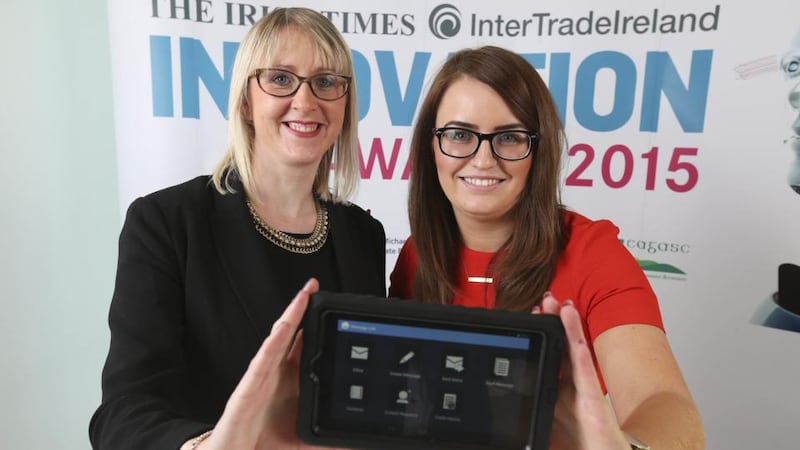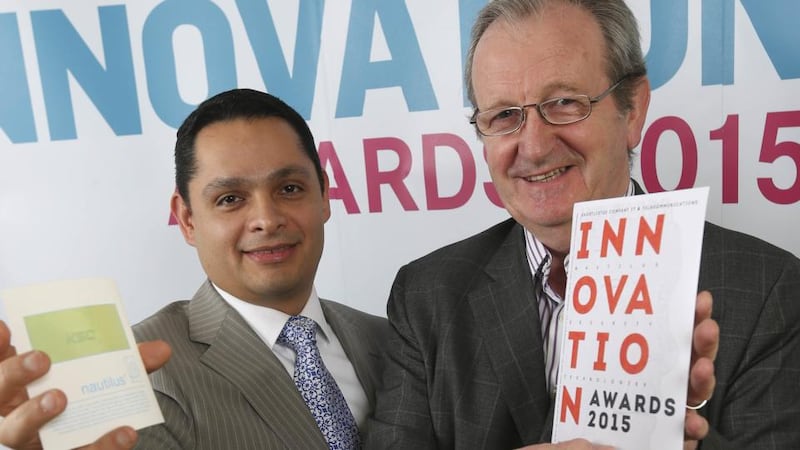Core Systems
Belfast-based Core Systems has developed a secure platform through which offenders in prison can directly and securely access information and services to which they are entitled.
Direct2inmate can be operated using an ATM-style kiosk or through tablet devices. It is designed specifically for use within secure environments such as prisons.


“We have been working with prisons for 15 years providing security devices such as locks, locking systems, doors and biometrics,” says marketing executive Emer O’Kane. “We got to know a lot about how prisons are run during that time. We also saw a shift in focus away from pure incarceration and more towards reform and rehabilitation.”
O’Kane points out that a lot of things that happen in prisons do so because the secure environment which the prison authorities wish to create.
“For example, if a prisoner wants to know when their next visit is due, they have to ask a prison officer, who then has to go to an office, look up the prisoner’s record on the computer, find the visit, write it down somewhere and then go back and find the prisoner and give them the information.
“This takes up a lot of time, when the officer should be keeping order and keeping the prisoners and staff safe. It can also be very frustrating for the prisoner. What happens if the officer is delayed for some reason and the visit is due in half an hour? They could end up missing a visit just because of the way the system works.”
Direct2inmate allows prisoners to access information like this for themselves, making the whole process more efficient and less frustrating.
“It has been designed in a way that the only change involved is for the prisoner,” O’Kane says.
“Prison authorities are naturally very risk-averse, and it is important not to change their systems. All jails have jail management systems, and we don’t change them in any way. All our system does is access them.”
The self-service system was first made available through kiosk-based computers.
“These were located on prison landings, the common areas shared by the prisoners,” she says. “However, as usage of the system grew, this could lead to queues and this is not necessarily a good thing in a prison environment.
“The only solution was to offer the system on a personal device such as a TV or a tablet. We developed a way to make the tablets as secure as the kiosk.”
The system monitors and records every keystroke and all services accessed by users. The tablets are also controlled remotely and their availability can be managed centrally. For example, good behaviour can be rewarded through extra time on them.
In addition, the system can be used for managing prison pay, with prisoners being able to order goods from the prison shop using them. There is also an important educational dimension.
“Educational services can be delivered through secure apps on the device,” O’Kane says. “In much the same was as people can access Open University courses at home, prisoners are able to sign in to a secure portal and access courses through a bespoke app.
“All the apps are designed to empower prisoners and to reduce the risk of re-offending after release.”
The very presence of the technology in the jails will help in this regard.
“It is estimated that prisons are between five and seven years behind the outside world when it comes to technology,” O’Kane says. “Prisoners need to upskill if they want to get a job or voluntary work when they are released, and the system helps with that. They can also use it to help find a place to stay when they get out.
“Quite frequently prisoners are released from jail with a small amount of money in their pocket and directions to the nearest bus stop; no thought is given to where they are going to sleep that night. This can lead to prisoners simply going back to the people they associated with before they went to jail and re-offending as a result.”
The system is already in use in the US and Northern Ireland and, with 10 million prisoners in jail worldwide, the market opportunity for it is very large indeed. However it cannot be marketed in a traditional wide-scale fashion.
“Because of the environment we sell into,” O’O’Kane says, “it has to be marketed on a one-to-one basis. We are developing relationships with prison operators around the world, and that is how we will grow sales in future.”
Sedicii
Online security is one of the most serious issues facing not just the financial services sector but consumers everywhere. Various statistics have been produced in relation to internet fraud, and they are all frightening.
Sage Pay produced figures in 2013 showing that Irish online consumers had been cheated out of more than €25 million the previous year.
The figures for the US are even more startling, with Javelin Research revealing that 12.6 million Americans lost $21 billion to internet fraudsters in 2012.
While there are various security systems and protocols in place to prevent fraud, the ever-more inventive criminal community keeps finding new ways to break them or get around them.
The most usual is simple password or identity theft.
"During our lifetime, most of us will end up having more than 150 different passwords and hundreds of log-in details," says Richard Coady, commercial director of Sedicii Innovations, an Irish firm that has developed a new system to make consumers and businesses safer online.
“We all have many forms of personal data stored on servers and so on,” he says, “which are vulnerable to theft in many ways.”
These range from highly sophisticated hacking of online commerce servers to simple phishing scams, which trick gullible consumers into sharing their personal data with criminals by sending them false messages claiming to be from their bank or other service provider and asking them to reconfirm details.
"Forrester Research has estimated that the cost of a data breach to a large company is $10 million and it can be much greater than that," Coady notes. "The recent hacking of Sony is a case in point. Breaches continue to happen, and the data being gathered is exploited for financial gain.
“You can buy consumer data on the black market for between $1 and $5 per record at the moment. It’s a big and profitable business.”
One of the chief points of vulnerability is where customer authentication data is sent from their computer to the server of an online shop or other service. The Sedicii solution works by never sending this data anywhere.
A consumer has one password, which they keep in their head or other secure location, but which they never share with anyone. This is known as the zero knowledge proof protocol.
“The concept is that you know what you know and you don’t tell anyone else what you know,” Coady explains. “That’s what makes it so secure. You never share the password with anyone else and you never send it to anyone else.”
That may sound self-contradictory, but it is anything but. Instead of sending an actual password out into the internet, the Sedicii system generates a unique graphic related to it, and it is that graphic that is sent to the server at the other end of the line.
However, that’s not the really clever bit. It’s in the way the site authenticates the graphic. It doesn’t simply compare the two graphics; if that were the case, it would be much the same as comparing password data. The authentication method utilised is a series of questions relating to the structure and design of the graphic on the consumer’s computer. For example, it asks if point X is connected to point Y and, if so, what the distance is and if the line between them is straight and so on.
Only if the answer is Yes will the next question be asked; one negative response ends the process. The whole authentication process is as fast as current methods but more secure.
“We are not changing the user experience,” Coady says. “We are just enhancing what goes on in the background. We are currently speaking to some of the major credit card companies and other potential customers.
“We are a start-up company and one of the key success factors in this sector is trust,” he adds. “It will be a slow process to build that, but we have won several industry awards already and are piloting the technology with a number of companies at the moment.”
Nautilus NI
Most of us will be familiar with the use of holograms for product security. They are integrated into packaging, and used on banknotes, credit cards and passports as an added layer of security to defeat the efforts of counterfeiters.
It is one thing to reproduce the image of a banknote or make a piece of plastic that looks physically identical to a real debit card. It’s another thing entirely to create and integrate an expensive hologram into it.
However, while they do add cost to the product in which they are being used, technological advances make holograms easier to counterfeit.
Newry-based Nautilus NI Ltd has come up with a novel solution to this challenge with its Tilt2View (T2V) technology.
Like a hologram, T2V changes colour when the user tilts the product or packaging.
Its cost is minimal compared with holograms or colour shift inks, it doesn’t require any special device to be decoded, adds no extra raw materials, creates no extra waste, and doesn’t affect the recycling of packaging or product.
The T2V feature is completely embedded into the product or packaging, making it impossible to be removed.
One key advantage of the solution is the fact that it doesn’t require any special inks and can be applied to any surface. That means it can effectively be designed into the packaging and even incorporated into branding.
It also makes it a lot more cost-effective than an alternative, which requires the insertion of an extra material or an additional printing process.
It also has the beauty of familiarity. A consumer picking up a product feature Tilt2View just tilts it in the same way as they would a hologram and the image changes colour or other features to authenticate the item.
The range of applications for the T2V solution is vast. Not only can it be used on products and documents where holograms and other printable security solutions are currently used, but it can be used on a whole range of others that were previously not seen as appropriate candidates for such measures due to their low cost.
The T2V solution adds so little to normal production and packaging costs that it can be used for almost anything.
Nautilus NI plans to continue the development of the solution in order to make it accessible to the widest possible market and range of applications.










